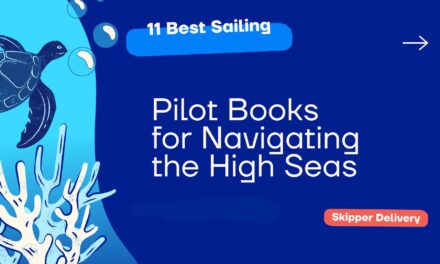You’re about to set sail on a journey through the most inspiring sailing books that will fuel your next sailing adventure. From the breathtaking photography in ‘On the Water’ to the compelling solo voyage in ‘Sailing Alone Around the World’, each book brings a unique perspective on life at sea. Whether you’re after practical seamanship tips or gripping tales of maritime challenges, these selections promise to ignite your passion for sailing. What makes these books stand out and how will they shape your next voyage? Let’s explore the stories in Best Sailing Books that have captivated sailors for generations.
On the Water: Iconic Maritime Photography from the Rosenfeld Collection
If you’re a sailing enthusiast or someone who loves the sea, ‘On the Water: A Century of Iconic Maritime Photography from the Rosenfeld Collection’ is a must-have for your collection.
This beautiful book showcases a stunning array of black and white photographs from the early 20th century, capturing the essence of maritime life. Each image is a tribute to the rich history and beauty of sailing, making it perfect for anyone who cherishes nautical adventures.
The photos aren’t only visually striking but also deeply appreciated by those who’ve a passion for the sea. Whether you’re looking to adorn your coffee table or immerse yourself in maritime nostalgia, this collection offers a timeless glimpse into the world of sailing.
Best For: Sailing enthusiasts and those who love the sea, looking to immerse themselves in nautical nostalgia through stunning early 20th-century maritime photography.
Pros: – Beautiful collection of black and white maritime photographs. – Captures the essence and history of early 20th-century sailing. – Perfect for coffee table display or as a gift for sea lovers.
Cons: – Limited to black and white photographs, which may not appeal to everyone. – Focused mainly on early 20th-century scenes, potentially lacking modern maritime imagery. – May be expensive for casual readers or those not deeply interested in maritime history.
Sailing Alone Around the World
For anyone fascinated by solo nautical exploits, ‘Sailing Alone Around the World’ offers an enthralling narrative of Joshua Slocum’s pioneering voyage. Departing Boston in 1895, Slocum spent three years circumnavigating the globe on the Spray, an old oyster boat he refitted himself.
His background as a Canadian mariner shines through his dated yet jolly writing style, which downplays dangers like pirate encounters and harsh weather. Slocum’s journey brought him face-to-face with notable figures and unexpected hospitality.
The book became a bestseller, leading to fame and even a visit from President McKinley. Despite the book’s inspiring nature, be cautious of poorly made editions. Slocum’s mysterious disappearance adds an enigmatic twist to his legacy.
Best For: Sailing enthusiasts and those interested in solo adventures on the high seas.
Pros: – Inspiring and captivating narrative of a pioneering solo voyage. – Engaging writing style that downplays dangers with jolly irony. – Historical significance as the first solo circumnavigation of the globe.
Cons: – Some editions may be poorly made with formatting and content issues. – Writing style may feel dated to modern readers. – Slocum’s mysterious disappearance leaves many unanswered questions.
Old Man Sailing: Some dreams take a lifetime
Looking for an engaging and inspirational read that’s perfect for aspiring ocean sailors with a sense of adventure? Check out ‘Old Man Sailing: Some dreams take a lifetime.’
A friend called it a ‘damned good read,’ and it’s well-written, providing just the right amount of detail to keep you hooked. John Passmore’s courage to sail single-handedly, especially during the Covid epidemic, is truly admirable. His book offers insights into the highs and lows of offshore sailing, making it relatable and inspiring.
Readers connected with his humor and experiences, finding it a feel-good read. Whether you’re looking for motivation or just an entertaining book, ‘Old Man Sailing’ is highly recommended for anyone interested in the nautical life.
Best For: Aspiring ocean sailors and adventure enthusiasts looking for an engaging and inspirational read.
Pros: – Well-written and engaging with just the right amount of detail. – Inspirational and motivational for those interested in sailing. – Humorous and clear writing style that keeps readers entertained.
Cons: – May not appeal to those without an interest in sailing. – Some readers might find the detailed sailing experiences less engaging. – The book’s focus on a single-handed sailing journey during the Covid epidemic might not resonate with everyone.
Yachting Monthlys Confessions: Yachtsmen Own Up to Their Sailing Sins
‘Yachting Monthlys Confessions: Yachtsmen Own Up to Their Sailing Sins’ is a must-read for any sailor who enjoys a hearty laugh while learning from the humorous mishaps of fellow enthusiasts. This book gathers true stories that are both hilarious and instructive, making your own sailing blunders seem trivial.
Readers rave about the book’s ability to resonate with any proper yachter, thanks to the brilliant illustrations by Mike Peyton. Whether you’re gifting it or indulging yourself, you’ll find the variety of experiences shared to be relatable and entertaining.
Expect lots of chortling and perhaps a bit of relief, knowing you’re not alone in your nautical misadventures. It’s a small book, but it packs plenty of laughter and valuable lessons.
Best For: Sailors and yachting enthusiasts who enjoy humorous and relatable tales of nautical mishaps.
Pros: – Hilarious and instructive true stories. – Brilliant illustrations by Mike Peyton. – Relatable content for any proper yachter.
Cons: – Smaller size than some might expect. – Primarily focused on sailing, not motor boating. – Limited appeal for non-sailors.
The Complete Yachtmaster: Sailing, Seamanship and Navigation for the Modern Yacht Skipper
The Complete Yachtmaster: Sailing, Seamanship and Navigation for the Modern Yacht Skipper is an indispensable guide for those aiming to achieve their Yachtmaster qualification with practical advice and a wealth of knowledge.
Tom Cunliffe’s light-hearted yet concise style guarantees that you won’t miss any critical information. Despite some criticisms about his humor and nostalgic tone, the book remains a top resource for modern yacht skippers.
Readers praise it for its well-structured content that covers all necessary aspects of sailing, seamanship, and navigation. It’s not just informative but also entertaining, making it a great gift for sailing enthusiasts.
If you’re preparing for your Yachtmaster theory exam or planning an ocean adventure, this book is a must-have.
Best For: Those preparing for their Yachtmaster qualification or planning extensive ocean sailing adventures.
Pros: – Comprehensive and practical advice on sailing, seamanship, and navigation. – Well-structured and informative content. – Entertaining and engaging writing style.
Cons: – Some readers find the humor and nostalgic tone distracting. – Writing style may seem slightly pompous to some. – Focuses on traditional methods over modern practices.
The Nautical Puzzle Book
Ideal for anyone with a nautical background or love for the sea, The Nautical Puzzle Book offers engaging and educational puzzles perfect for downtime on or off the water. Readers praise its variety of challenges, from fascinating nautical trivia to intricate puzzles that spark both learning and fun.
Whether you’re an ex-Navy veteran, a sailing enthusiast, or just someone who enjoys maritime lore, this book provides a captivating way to pass the time.
Reviewers highlight its suitability as a thoughtful gift, noting how recipients, whether on a ship for the holidays or ashore, find it both enjoyable and enlightening. It’s a lightweight, easily shipped option that brings joy and knowledge, making it perfect for short, relaxing breaks.
Best For: Ideal for anyone with a nautical background or a love for the sea, including ex-Navy veterans, sailing enthusiasts, and maritime lore lovers.
Pros: – Engaging and educational puzzles that are perfect for downtime. – Lightweight and easily shipped, making it a great gift option. – Provides a variety of challenges that spark both learning and fun.
Cons: – Some may find the price a bit high. – Limited appeal for those without an interest in nautical themes. – Puzzles may be too specific for casual puzzle enthusiasts.
Sailing Around Britain – A Weekend Sailor’s Voyage in 50 Day Sails
Focusing on the unique concept of day sailing, Sailing Around Britain – A Weekend Sailor’s Voyage in 50 Day Sails is perfect for those who relish exploring local histories and coastal cultures one day at a time.
The author captures the essence of these voyages, providing fascinating insights into the local history and culture of each area. Readers appreciate this fresh approach, enjoying the book’s detailed observations.
However, be prepared for a somewhat grumpy narrative; the author often complains about facilities, town amenities, and cultural celebrations. Despite the mixed reviews, the book’s concept of breaking Britain into manageable day sails offers valuable insights for potential sailors.
If you’re intrigued by local lore and day sailing, this book might just inspire your next nautical adventure.
Best For: Those who relish exploring local histories and coastal cultures through a unique concept of day sailing.
Pros: – Captures the essence of sailing voyages with detailed observations. – Provides fascinating insights into local history and culture. – Offers a fresh approach by breaking Britain into manageable day sails.
Cons: – Contains a somewhat grumpy and complaint-filled narrative. – The author’s negative attitude towards various locations and cultures. – Criticized for being more about complaints than actual sailing knowledge.
The Sailing Handbook: A Complete Guide for Beginners
For beginner sailors keen to explore the world of yachting, ‘The Sailing Handbook: A Complete Guide for Beginners’ offers a fantastic manual with clear narratives and good illustrations. This book is highly praised for its thorough coverage of most aspects of sailing.
Novice sailors will find it especially helpful, as it provides a solid foundation to start their nautical journey. The clear narrative and well-chosen pictures make complex concepts easier to grasp.
However, some readers feel it’s a bit too all-encompassing and doesn’t cover sailing and docking in sufficient detail. Despite this, many enjoy the experience of learning about sailing from the comfort of their office.
Overall, it’s a great resource to get started on your yachting adventure.
Best For: Novice sailors seeking a comprehensive introduction to the fundamentals of yachting.
Pros: – Clear narrative with good illustrations. – Covers most aspects of the subject. – Very helpful for beginners.
Cons: – Too general. – Insufficient detail on sailing and docking. – May not satisfy experienced sailors.
Sails, Skippers and Sextants: A History of Sailing in 50 Inventors and Innovations
‘Sails, Skippers and Sextants: A History of Sailing in 50 Inventors and Innovations’ is packed with engaging, readable gems that make it a must-read for any boating enthusiast. This fascinating book explores the history of sailing through the lens of 50 key inventors and innovations, focusing on old traditional sailboats and maritime safety.
You’ll uncover intriguing facts about navigational aids and the evolution of sea travel, making it an excellent fireside read. While it does have a Brit-centric focus and some critique over its portrayal of Nathaniel Herreshoff, it’s still highly recommended for its informative content.
Ideal for sailors and anyone curious about the maritime world, it’s a book you won’t want to miss.
Best For: Boating enthusiasts and anyone curious about the maritime world.
Pros: – Engaging and informative content – Focus on traditional sailboats and maritime safety – Packed with interesting facts and history of navigational aids
Cons: – Brit-centric focus on innovations – Some concepts not properly explained – Criticism over portrayal of Nathaniel Herreshoff
The Complete Sailing Manual
The Complete Sailing Manual stands out as an essential guide for both novice sailors and seasoned mariners, providing thorough coverage and beautifully laid-out illustrations. You’ll find this book incredibly well put together, with robust content that’s easy to understand. It’s perfect for anyone looking to explore the world of sailing or expand their existing knowledge.
Many reviews highlight its usefulness as a reference book for RYA courses and its extensive coverage of relevant sailing topics. Despite some reports of minor shipping damage, the overall feedback is overwhelmingly positive.
This manual serves as a valuable companion on your nautical adventures, offering high-quality information and clear images to help you navigate the seas confidently.
Best For: Sailing enthusiasts of all levels, from beginners to experienced sailors, looking for a comprehensive and well-illustrated guide to enhance their knowledge.
Pros: – Thorough coverage of sailing topics suitable for both novices and seasoned sailors. – Beautifully laid-out illustrations and clear, elucidative images. – High-quality content, useful for RYA courses and general sailing reference.
Cons: – Some reports of minor shipping damage. – Slight issues with delivery condition affecting the physical book. – Potential disappointment if the book arrives damaged despite its robust content.
A Voyage For Madmen: Nine Men Race Around the World
Engaging and enlightening, ‘A Voyage For Madmen’ by Peter Nichols is perfect for those seeking a profound and thrilling tale of human resilience and nautical adventure. This gripping narrative chronicles the 1968 Golden Globe race where nine men attempt a nonstop, solo circumnavigation. Nichols masterfully captures the mental challenges they face, including loneliness, fear, and madness. Praised for its humor, tragedy, and uplifting moments, the book offers deep insight into each sailor’s unique experience.
Readers commend Nichols for his sailing expertise and compelling storytelling. His vivid descriptions and character development keep you hooked.
While some technical sailing terms may pose a challenge, the book’s global reach and impact make it a must-read for adventure enthusiasts.
Best For: Those seeking a profound and thrilling tale of human resilience and nautical adventure.
Pros: – Gripping narrative that captures the mental challenges of solo circumnavigation. – Praised for its humor, tragedy, and uplifting moments. – Vivid descriptions and character development keep readers engaged.
Cons: – Technical sailing terms may pose a challenge for some readers. – Discrepancies in the condition of second-hand copies. – Price variations for used books might not always reflect the quality.
Fifty Places to Sail Before You Die
Perfect for sailing enthusiasts, ‘Fifty Places to Sail Before You Die’ offers a blend of mesmerizing destinations and practical insights that can spark your next nautical adventure. The book has received glowing reviews for its engaging descriptions and beautiful photographs, making it a cherished gift for sailors.
Readers appreciate its ability to awaken interest in diverse locations, even though it leans heavily towards U.S.-centric destinations. Some critics note that the articles are often brief and lack depth, but the overall value remains high.
Whether you’re planning trips or just dreaming, this book promises to inspire. Despite minor flaws like a worn cover, it’s praised for its prompt delivery and matching descriptions. Ideal for anyone passionate about sailing and travel.
Best For: Sailing enthusiasts looking for inspiration and practical insights for their next nautical adventure.
Pros: – Engaging descriptions and beautiful photographs – Highly praised as a gift for sailors – Sparks interest in diverse sailing destinations
Cons: – Articles are brief and lack depth – Heavily U.S.-centric in its choice of locations – Some copies may have a worn cover not mentioned in the description
The Impractical Boat Owner: Tales and Trials from Years of Floundering Afloat
Looking for a humorous and insightful read that captures the real-life escapades of sailing enthusiasts? The Impractical Boat Owner: Tales and Trials from Years of Floundering Afloat delivers just that.
Readers rave about its funny, smart, and invigorating approach to sailing mishaps. If you’re a sailor, you’ll appreciate the author’s wit and candid honesty—no romanticized tales here, just genuine nautical experiences.
The illustrations add an extra layer of enjoyment. Whether you’re a seasoned sailor or someone who simply enjoys a good maritime yarn, this book offers a delightful look into the challenges and joys of life afloat.
Many have found it to be the perfect gift for sailor friends, making it a well-received addition to any nautical library.
Best For: Sailing enthusiasts and maritime humor lovers who appreciate candid and witty nautical tales.
Pros: – Funny and smart writing style – Delightful illustrations – Well-received as a gift for sailors
Cons: – May not appeal to non-sailors – Some might prefer more serious nautical accounts – Limited appeal outside the sailing community
Factors to Consider When Choosing Sailing Books
When choosing sailing books, you should consider who the book is aimed at and your own level of experience.
Think about whether you prefer a particular writing style, the depth of content, and the balance between text and visuals.
Also, decide if you want a book focused on historical adventures or practical sailing advice.
Audience and Experience Level
When selecting sailing books, it’s important to take into account the reader’s experience level to guarantee the material is both engaging and informative. If you’re a beginner, you’ll want books that simplify sailing terminology, navigation techniques, and basic seamanship. These books should offer clear instructions and easy-to-understand language.
For those with more experience, look for books that explore advanced techniques, complex navigation, and in-depth discussions about yacht racing or offshore voyages.
It’s also vital to think about the reader’s specific interests. Are you fascinated by maritime history, or do you prefer thrilling sailing adventures? Maybe you’re looking for instructional guides or humorous anecdotes to lighten the mood. Matching the book’s content to these interests ensures a more enjoyable read.
Another important factor is the type of sailing you prefer. Whether you love solo sailing, coastal cruising, or competitive yacht racing, choose books that align with these preferences. They’ll provide relevant insights and keep you engaged.
Lastly, assess the depth of technical information. A book heavy on technical details might overwhelm a novice but be perfect for an experienced sailor looking to expand their knowledge. By taking these factors into account, you’ll find the perfect sailing book for your next nautical adventure.
Writing Style Preferences
Beyond aligning the book with your experience level, you’ll also want to contemplate the writing style that keeps you engrossed and keen to turn the page. Do you prefer a light-hearted and humorous tone, or does a more serious and technical approach catch your interest? Identifying your preference can make a significant difference in your reading experience.
Think about whether you enjoy storytelling or instructional content, or perhaps a blend of both. Some books weave personal anecdotes and reflections into their narrative, offering a personal touch that can make the sailing experience come alive. If vivid, descriptive language that paints a picturesque scene of the ocean and the sailing journey excites you, look for authors who excel in this style.
On the other hand, if you favor straightforward, concise writing without too much embellishment, aim for authors who get straight to the point. It’s important to choose books that match your reading preferences to make sure you stay engaged and motivated to learn more.
Content Depth and Breadth
As you choose a sailing book, focus on the importance and thoroughness of its content to guarantee it thoroughly covers essential topics like navigation, seamanship, and safety. A good sailing book should provide a broad range of information, catering to both beginners and advanced sailors. Look for books that start with the basics and gradually build up to more complex techniques.
It’s vital to find a sailing book with detailed explanations and practical advice. Real-life examples and tips can greatly enhance your learning experience, making theoretical concepts more relatable and easier to grasp. Make sure the book offers extensive coverage of diverse sailing topics such as boat handling, weather reading, emergency procedures, and sailing history. This will give you a well-rounded understanding of the nautical world.
Additionally, consider whether the book explores advanced topics for those looking to deepen their skills. This might include intricate navigation methods, advanced seamanship techniques, and sophisticated safety protocols. By ensuring the book you choose covers a wide array of subjects with ample depth, you’ll be better prepared for any sailing adventure, equipped with both fundamental knowledge and advanced insights.
Illustrations and Visuals
Illustrations and visuals in sailing books play an essential role in enhancing your understanding of intricate sailing concepts and techniques. When you’re learning about knots, sail trim, or navigation, clear and detailed diagrams can make a world of difference. They allow you to visualize the steps and nuances of each maneuver, making it easier to grasp and replicate them on your own vessel.
High-quality photographs are another crucial component. They don’t just add aesthetic value; they can evoke a sense of adventure and deepen your appreciation for the sea. Pictures of sailboats, maritime scenes, and idyllic destinations can inspire you to seek out new experiences and broaden your horizons.
Maps and charts are invaluable for route planning and understanding nautical terms. They provide practical insights into new sailing areas, helping you to navigate unfamiliar waters with confidence.
Well-designed graphics and illustrations make learning about sailing more engaging and accessible, regardless of your experience level. They break down complex information into digestible visuals, ensuring you retain the knowledge you need for a successful nautical adventure.
Ultimately, choosing a sailing book with detailed visuals can greatly enhance your learning and enjoyment, making your sailing journey more rewarding.
Historical Vs. Practical Focus
When selecting sailing books, consider whether you’re looking for inspiration from historical tales or practical advice for modern sailing techniques. Historical sailing books often delve into the rich maritime history, capturing the essence of past adventures and achievements. You’ll come across legendary voyages, famous sailors, and significant maritime events that shaped sailing history. These stories can be incredibly motivating, sparking your imagination and deepening your appreciation for the nautical world.
On the other hand, practical sailing books provide hands-on guidance, tips, and techniques for modern sailors. If you’re seeking to enhance your skills and knowledge, these books are invaluable. They cover essential topics like navigation, boat handling, and troubleshooting common issues you might encounter on the water. Practical books are designed to help you overcome real-world challenges, making your sailing experiences safer and more enjoyable.
Choosing between historical and practical sailing books depends on your current needs and interests. If you’re captivated by the romance and adventure of the past, historical books are the way to go. But if you’re keen to improve your sailing techniques and gain practical knowledge, opt for modern guides. Ultimately, both types of books can enrich your nautical journey in unique ways.
Condition and Format
To choose the best sailing book, start by considering the book’s condition and format to make sure it meets your needs. First, decide whether you want a new, used, or specific edition of the book. New books offer pristine quality, while used ones can be more affordable, though you should check for any wear or damage. Specific editions might have unique features or sentimental value.
Next, think about the format. Hardcovers are durable and great for long-term use, but they can be bulky. Paperbacks are lighter and more portable, while digital versions are convenient for on-the-go reading and often come with interactive features.
Features like illustrations, photos, and diagrams can greatly enhance your learning experience, especially if you’re a visual learner. These elements can clarify complex sailing techniques or provide inspiring visuals of nautical adventures.
Also, make sure to get the latest edition if possible. Updated content or revisions can provide more accurate and current information, which is essential for practical sailing knowledge.
Lastly, consider the book’s size and layout. A well-spaced, readable font and a manageable book size can make your reading experience much more pleasant, ensuring you can easily digest the material.








